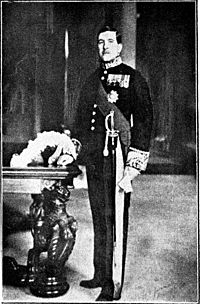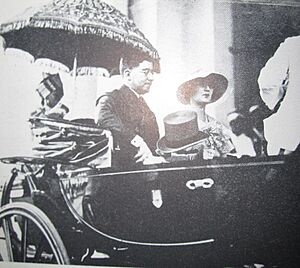John Erskine, Lord Erskine facts for kids
Quick facts for kids
Lord Erskine
|
|
|---|---|

Lord Erskine in 1940.
|
|
| Governor of Madras Presidency | |
| In office 15 November 1934 – 18 June 1936 |
|
| Governor-General | The Marquess of Willingdon, The Marquess of Linlithgow |
| Premier | Ramakrishna Ranga Rao of Bobbili, P. T. Rajan |
| Preceded by | Hon. Sir George Frederick Stanley |
| Succeeded by | Sir Kurma Venkata Reddy Naidu (acting) |
| In office 1 October 1936 – 12 March 1940 |
|
| Governor-General | The Marquess of Linlithgow |
| Premier | P. T. Rajan, Kurma Venkata Reddy Naidu, Chakravarti Rajagopalachari |
| Preceded by | Sir Kurma Venkata Reddy Naidu (acting) |
| Succeeded by | Hon. Arthur Hope |
| Personal details | |
| Born | 12 April 1895 |
| Died | 3 May 1953 (aged 58) United Kingdom |
| Nationality | British |
| Political party | Conservative |
| Spouse | Lady Marjorie Hervey |
| Alma mater | Eton, Christ Church, Oxford |
| Occupation | politician, administrator |
| Profession | soldier |
John Francis Ashley Erskine, known as Lord Erskine, was an important British figure. He was a soldier, a politician, and an administrator. Born on April 12, 1895, he lived until May 3, 1953. Lord Erskine was a member of the Conservative Party. He served as a Member of Parliament (MP) for areas like Weston-super-Mare and Brighton.
From 1934 to 1940, Erskine also served as the Governor of Madras Presidency, a large region in British India. He was a close friend of the Indian politician Chakravarthi Rajagopalachari. However, they sometimes disagreed on political ideas. After his time as Governor, Erskine returned to the United Kingdom. He continued to serve as an MP for Brighton for a short period.
Contents
Early Life and Family Background
John Erskine was born on April 12, 1895. His father was Walter Erskine, 12th Earl of Mar, and his mother was Lady Violet Ashley Cooper. John was the older of their two sons.
He received his education at two well-known places. First, he attended Eton, a famous boarding school. Later, he studied at Christ Church, which is part of Oxford University.
In 1919, John Erskine married Lady Marjorie Hervey. She was the daughter of the 4th Marquess of Bristol. Together, they had four sons.
Military Service
When the First World War began, John Erskine joined the army. He became a soldier in the Scots Guards. By the end of the war, he had been promoted. He reached the rank of Major in the Argyll and Sutherland Highlanders.
Political Career
After his military service, Erskine became interested in politics. He joined the Conservative Party. In 1920, he started working as an Assistant Private Secretary for Viscount Long.
In the 1922 election, Erskine was elected as an MP. He represented the area of Weston-super-Mare. He lost his seat in the 1923 election but won it back easily in 1924.
Erskine was a confident speaker in the House of Commons. He was very interested in the affairs of India, even though he had never visited the country. He closely followed important discussions about India in the early 1930s.
In 1931, Erskine was appointed as an unpaid Assistant Government whip. A whip is a person who helps make sure party members vote in a certain way. This role meant he usually didn't give speeches in Parliament anymore.
Later in his career, Erskine served as an MP for Brighton. He supported the idea of India having its own rule. This view was different from Winston Churchill's, who opposed the Government of India Act 1935.
Governor of Madras Presidency
On May 22, 1934, Lord Erskine was chosen to be the new Governor of Madras. He officially started his role in November of that year. As Governor, he was a key leader in the region.
Erskine served as Governor of Madras Presidency from 1934 to 1940. He took over from George Frederick Stanley. Erskine supported the Justice Party in Madras. He hoped they would win the 1937 elections.
However, the Indian National Congress won by a large margin. The Congress Party refused to form a government at first. They were concerned about the special powers given to the Governor by the Government of India Act 1935.
Erskine then formed a temporary government. He appointed Kurma Venkata Reddy Naidu of the Justice Party as the leader. Eventually, the Congress Party agreed to form a government. On July 14, Chakravarthi Rajagopalachari, the Congress leader, became the Premier.
Erskine and Rajagopalachari had a good personal relationship. They often worked well together. However, they did have disagreements on some policies. For example, Erskine disagreed with Rajagopalachari's use of a certain law during the Anti-Hindi agitations in 1938.
Erskine also enjoyed visiting the Nilgiri Hills. In 1935, he called the town of Kotagiri the "Princess among Hill Stations." During his time as Governor, the first regular radio service in Madras began in 1938. This was when All India Radio opened its station in Madras.
In October 1939, the Congress ministry resigned. This happened because of the start of the Second World War. Erskine then declared an emergency and took control of the administration. He also repealed a law that made Hindi study compulsory, which had been unpopular.
Later Years
After his time as Governor, Lord Erskine returned to the United Kingdom. He decided to leave politics. He moved to his home at Ickworth near Bury St Edmunds. He continued to share his thoughts on Indian affairs.
Sadly, his second son was killed in action in 1945. Lord Erskine was active in local volunteer work. He became the President of the Navy League. He had a major operation in the early 1950s that affected his health. Lord Erskine passed away in 1953 at the age of 58.


